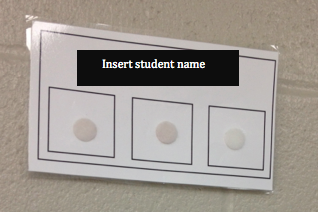Exactly 30 days after the first day of school, teachers must send home
the first term IEP’s (Individual Education Plans). This thought in itself was daunting for me. This meant I had to get to know my
students (likes, dislikes, reinforcers, etc), assess their academic abilities
and write my first ever IEP (make that 5) in less than 30 days. The whole process was overwhelming and
I had no idea where to begin!
Simple put, in order to make challenging yet achievable goals for your
students; you must first know what they already CAN do. I used a variety of sources to help me
assess where my students were at the beginning of the school year.
Parents
A student’s parents are one of your best resources. They know their child inside and out,
and are often able to give information that others could not. I met with all of my families the week
before school started, and together we co-created profiles of their child
(medical history, communication, behaviour, academic abilities, levels of
independence, etc.) This was a
quick way to gain an understanding of each student, and is great to have for
reference in meetings, when supply teachers come in, etc.
OSR’s
The Ontario Student Record (OSR) is the
record of a student's educational progress through schools in Ontario. It also
is a great source for gaining valuable knowledge about your students. Why reinvent the wheel if someone has
already done some assessment for you?
Quite often with students with autism,
the OSR is massive. Go grab a
coffee and get ready to do some serious digging!! I found it useful to read recent psychology
reports/assessments, health/medical reports, consultations and assessments from
Speech and Language as well as the Occupational Therapists and any reports form
outside agencies (specifically IBI).
Report Cards
The purpose of provincial report
cards is to communicate how well a student has achieved the overall curriculum
expectations for each subject at the end of a period of learning. (e.g., end of
term 1 and end of year).
I read through each student’s
report cards to gain a better understanding of the types of modified curriculum
expectations they were working on, and whether or not they were able to achieve
the expectations as of June of last year,
ABLLS
I was shown this assessment tool
from one of my colleagues and I absolutely LOVE it. It is amazing for students who are lower functioning, have
emerging verbal/academic skills, and/or are typically developing at a kindergartener/grade
1 level.
There are 26 skills areas, from
visual performance, to labeling, to reading. And within each skill area is a bunch of tasks. You rate how well the student can
accomplish each task using a rubric.
It is extremely easy to use, and although time consuming, very worth it!
You can even colour code the
rubric to continuously assess during the year and document growth.
PM Benchmarks
For my higher functioning
students, I used PM Benchmarks to assess reading fluency, comprehension,
reading quantity and quality, level of text, and attitudes and interests in
response to what students are reading. This helped me determine the
student’s “level” of reading, strengths, and needs.
Observation
One of the best pieces of advice I
received within the first week of school was: “Don’t stress about the academics.
Get to know the students and allow the students an opportunity to get to
know you and the classroom… the rest will come.”
With so
much to get done, it seems silly to sit back and observe your students. However, purposeful observation offers
so many benefits. My staff and I
made a strong effort to focus on observing the students’ current skills,
strengths, weaknesses, likes and dislikes, and this information informed a lot (if
not the most) of my planning.
Now that
you’ve gathered all the information you need, you can start to write your IEP’s….
but that’s a whole other post in itself!!
More to
come!
Keep calm and teach on!
- S


























